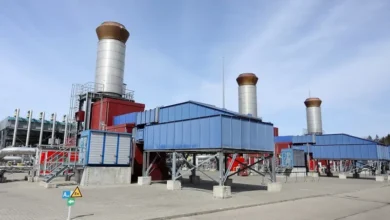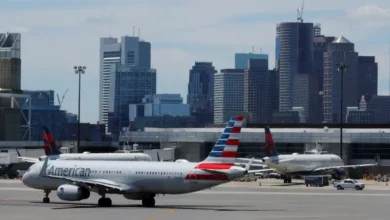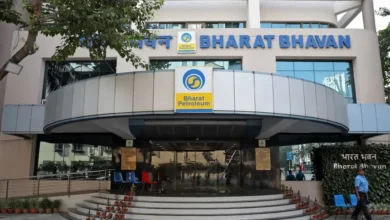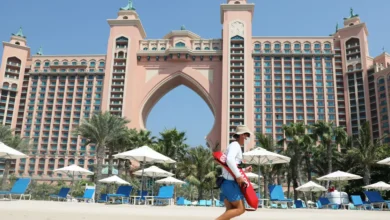UAE soon to have a train to catch as Etihad Rail advances, GCC network shows promise
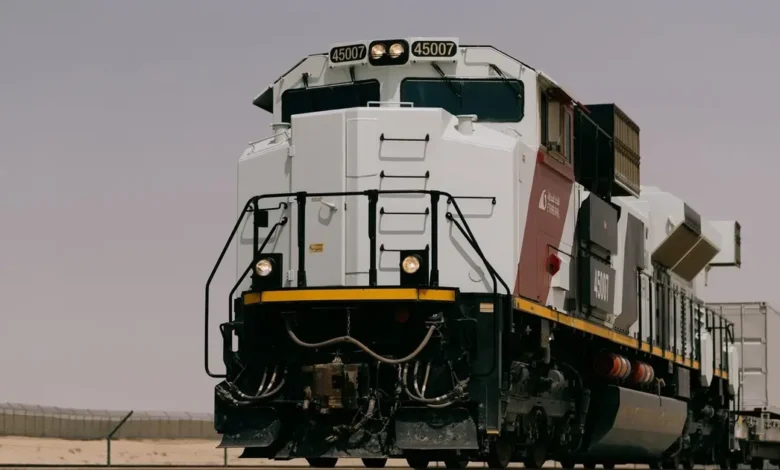
Etihad Rail, the UAE’s ambitious railway project that seeks to transform the way people commute within the country and the wider region, as well as promote ease of conducting trade and commerce, is currently on a fast track towards becoming a reality. This futuristic rail network aims to incubate economic opportunities to the tune of $200 billion for the country.
Starting with the launch of the UAE-wide freight services and the announcement of a forthcoming luxury rail service in the region, Etihad Rail is making headway on the mega project first announced 14 years ago, with the aim of linking all the seven emirates and connecting the country’s major ports and logistics hubs.
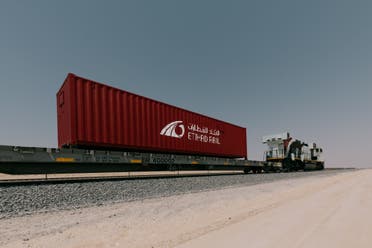
Etihad Rail was formed in 2009 under Federal Law No. 2 with the mandate of managing the development, construction and operation of the UAE’s national rail network, which was built to link the principal centers of industry, manufacturing, production, population and import/export points in the country and form a vital part of the planned GCC railway network.
Etihad Rail’s network is already improving the way goods and people move, opening up new trade corridors and journey opportunities. The railway network is being developed and operated in tandem with Abu Dhabi Economic Vision 2030 and UAE Centennial 2071.
Since 2016, Etihad Rail has been successfully operating a route that spans 264km, transporting granulated sulphur from sources at Shah and Habshan, the southwestern part of Abu Dhabi, to the industrial hub of al-Ruwais, about 240km west of Abu Dhabi city.
However, Etihad Rail’s pivotal moment came in December 2021, when Sheikh Mohammed bin Rashid Al Maktoum, Vice-President and Prime Minister of the UAE and Ruler of Dubai, and Sheikh Mohamed bin Zayed Al Nahyan, Crown Prince of Abu Dhabi, launched the UAE Railways Programme, an initiative that aimed to revolutionize the transportation sector in the country and pave the way for a sustainable future, integrating a vast network of railways for both goods and passengers.
With an investment of Dh50 billion, the UAE Railways Programme comprises three strategic projects, each designed to transform the nation’s transportation landscape.
Getting the freight network up-and-running
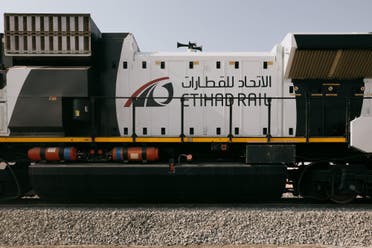
The first part of the freight network saw successful completion of the UAE National Rail Network, which Sheikh Mohammed bin Rashid announced fully operational in February this year.
He had said at the time: “We are proud of the performance of our sons and daughters who have worked hard over the years to build an ambitious, strategic project that will propel our national economy to greater heights.”
He added: “Connecting the emirates via a national railway network strengthens our capabilities and competitiveness and consolidates our unity.”
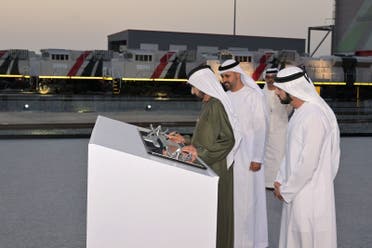
The state-of-the-art freight network allows seamless and efficient transportation for goods, ensuring a swift and transparent transition from factory to customer and thereby bolstering the country’s trade and economy.
The network consists of a fleet of 38 locomotives and more than 1,000 wagons.
Each freight locomotive operates with a power of 4,500 horsepower, equivalent to 3,400 kilowatts. It is one of the most powerful freight train engines in the Middle East.
In total, 11 contractors, 25 consultants and 28,000 specialists have worked on the project that took 133 million working hours to complete, involving 40,000 approvals from 180 government agencies.
Transporting passengers
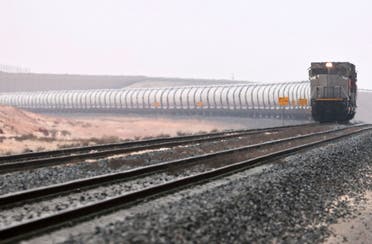
Etihad Rail is also planning to launch a passenger service, integrated with smart transportation solutions, with the goal of transporting more than 36.5 million passengers every year by 2030.
Construction on the network expansion to connect the emirates spanning across the entire UAE, from Ghuwaifat on the border with Saudi Arabia to Fujairah on the eastern coast, began in January 2020. Major new developments have already been seen in 2023, when Etihad Rail inaugurated the network expansion, spanning around 900km, linking all the seven emirates and launched freight operations across the UAE.
Earlier this year, it was also announced that luxury passenger train carriages will run be-tween the emirate of Fujairah and the Liwa desert in Abu Dhabi as part of a new agreement with Italy’s Arsenale Group.
The agreement is expected to bring an Orient Express-style service to the Gulf country that will later be extended throughout the GCC.
The 15 luxury coaches will feature designs from Emirati culture and will be built in the south of Italy. The train, once operational, will travel through Abu Dhabi and Dubai, extending to Fujairah, with a mountain view overlooking the sea, towards the border with Oman, and passing through Mezeira’a and the Liwa Desert. Etihad Rail has confirmed this in a statement at the time.
Last June, Etihad Rail announced that its first passenger train station will be located in Fujairah and will connect 11 areas across the UAE — from Al Sila to Fujairah — once completed.
Once the rail service begins, UAE commuters will be able to ditch their cars and travel from Abu Dhabi to Dubai in just 50 minutes. While a 100-minute journey from Abu Dhabi will take them to Fujairah, a 50-minute commute between Dubai and Fujairah and a 70-minute journey between Abu Dhabi and Ruwais will also be possible.
Logistics have also been developed in order to get passengers to the commuter stops.
During this May’s Middle East Rail event in the UAE, Etihad Rail and ride-hailing app Uber inked a preliminary agreement to join hands. As part of this collaboration, the two entities will focus on bolstering first and last-mile connectivity while expanding their services across the UAE.
More than two-thirds of the line have already been constructed. Etihad Rail said the mega network will offer a range of cutting-edge benefits to commuters, that will be “cheaper, faster, safer, more reliable and offer more environmentally sustainable services”. “Economically, the rail network will inspire businesses to use their time and resources more efficiently,” a statement supplied to Al Arabiya English added.
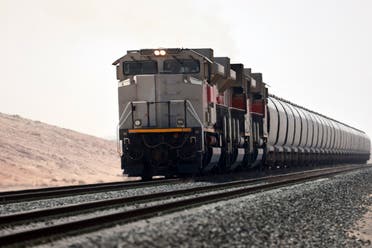
The UAE Railways Programme is not just about improved transportation, it also aims to generate substantial economic, social and environmental benefits for the country and its people. Over the next 50 years, it is expected to yield numerous advantages, including a secure transportation link between the UAE and the region that will help reduce trade costs significantly.
Economically, an estimated savings of $3 billion (Dh11 billion) in travel time, cost and distance between stations is projected, alongside $6 billion (Dh22 billion) in savings from re-duced accidents and $6.3 billion (Dh23 billion) in broader economic benefits, such as enhanced accessibility, land usage and productivity.
Moreover, the rail network is expected to save $2.2 billion (Dh8 billion) in road maintenance expenses.
Boost for sustainability
From an environmental perspective, the UAE Railways Programme aligns with the nation’s commitment to the Net Zero 2050 agenda. By 2050, the country aims to reduce its CO2 emissions in the road transport sector by a remarkable 21 percent annually, contributing sig-nificantly to combating climate change and promoting sustainability, which has been at the core of Etihad Rail’s values since its inception.
Once complete, the railway project will span 1,200 km across the UAE, passing through nine tunnels and covering seven logistics centers and four major ports in Ruwais, the Industrial City of Abu Dhabi (ICAD), Khalifa Port, Dubai Industrial City (DIC), Jebel Ali Port, Al Ghayel Dry Port and Fujairah Port.
It will have a fleet of 38 locomotives which is projected to transport more than 60 million tonnes of annual freight capacity.
GCC rail links
Etihad Rail is also expected to provide a vital transport link beyond the UAE’s borders.
In September 2022, on the sidelines of the UAE President Sheikh Mohammed bin Zayed Al Nahyan’s visit to Oman, Etihad Rail and Oman Rail, the Sultanate’s national developer and operator of railway networks, signed an agreement to establish Oman and Etihad Rail, a joint venture, equally owned by the two entities, with the goal of designing, building and operating a railway network that links Sohar Port to the UAE National Rail Network, with an investment of $3 billion.
The deal will see the two GCC countries linked by a 303-km passenger rail line, connecting Abu Dhabi with Sohar in the north of Muscat.
The newly-created entity will involve an overall investment of $3 billion to design, develop and operate a railway network that will connect Sohar Port to the UAE National Rail Net-work.
The much-anticipated railway line will primarily link Sohar to Abu Dhabi.
The passenger trains will reduce travel time from Sohar to Abu Dhabi to 100 minutes, and from Sohar to Al Ain to 47 minutes, travelling at a maximum speed of 200 km/hr. The freight trains will run at speeds up to 120 km/hr.
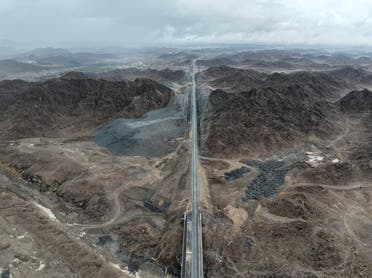
Political, economic impact
The rail link between Sohar in Oman and Al Ain in the UAE will likely be the first interconnected line in the GCC, Ed James the Middle East and Africa Head of Content and Re-search at MEED told Al Arabiya English.
At least three to four years away from taking shape, according to James, the UAE-Oman connect stems from the 2022 agreement between the two GCC countries to develop the trans-border network.
The $3 billion joint venture as of March was inviting pre-qualification bids from firms specialized in mega infrastructure projects. James said that this link, and others that will form in the years to come, can have an impact economically and politically.
As for a fully developed inter-GCC rail network, James said 2030 could be a target if all the concerned authorities meet now and take action. “It’s not necessarily new for the Middle East,” he said, referring to the 1,320-kilometer-long Hejaz railway built in the 1900s during the rule of the Ottoman Empire, between Damascus, Syria and Medina.
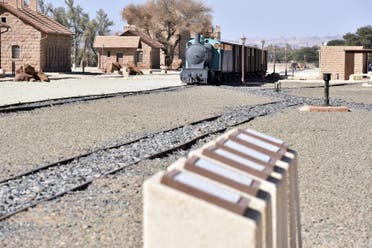
Calling the economic impact of the potential network the “biggest” factor, James said the GCC railway as it stands is primarily based on transporting cargo and freight between different cities. “Economically, we have the benefits of using different ports – the lower pollution, less traffic on the roads, the theoretical lower cost and the quick and easy facilitation of container traffic and freight cargo between different countries.”
If the trains have a high-speed element, it can move people between cities and countries and have implications on regional air travel, James added.
Looking at phase one of Etihad Rail which involved transporting sulfur and – in phase two – a freight railway, “it is all about transporting freight, and getting lorries off the road and making it cheaper and more efficient,” James said.
“If you look at the GCC railway from a freight perspective, what it enables is when you have, for example, the connection up in Sohar with the UAE, it will allow freight to land in Sohar port and then be transported into the UAE and of course vice versa from the UAE into Sohar.”
“But it also has implications around shipping routes and shipping cargo transit, because theoretically, freight shipping companies could take control of their cargo in Sohar and it can be transported via the railway link into the UAE.”
This route “theoretically means that some shipping companies don’t need to go all the way to Jebel Ali port [in Dubai] or Khalifa port [in Abu Dhabi] to do that,” he added.
James listed some advantages like quicker distribution, lower costs, and the possibility of avoiding geopolitical bottlenecks once the rail network takes shape.
“This issue around access to ports is one of the reasons… why there has been a long delay in the development of a GCC railway network,” James said, adding “GCC railway plans have been there for at least a decade.”
The UAE-Oman rail network, according to reports from 2016, was cancelled bilaterally after other GCC countries took a step back from internal rail development before the AlUla Summit in Saudi Arabia in 2021 revived the project. “It is somewhat of a sensitive issue,” James said.
Operational issues like sharing costs for upkeep and technical variations between locomotives and tracks can hamper the GCC-wide network’s development.
“Now we are starting to see the implementation. The Oman link with the UAE is the first obvious indication of that,” the researcher added.
Other projects like the Bahrain causeway to Saudi Arabia, Kuwait’s rail network also to Saudi Arabia, and Qatar’s multiple long distance railway projects planned for the 2025-2030 period are also taking shape.
“And of course, Saudi Arabia’s plans for the long-awaited land bridge project from Jeddah through Riyadh to Dammam will be a core component of any regional railway network,” James said. The Kingdom shares borders with all GCC countries, making it a key element of a Gulf rail network.
However, if the economic case for a high-speed transnational rail network must be made, he added that convenient travel internally must be mastered.
In the case of the Etihad Rail, James said it was primarily designed as a freight network with a passenger rail element “tacked onto it.”
“The economic case is challenging to make because you don’t know ultimately how many people get to use this.”
“In the region where people are wedded to cars, that’s also another factor you have to bear in mind.”
“Let’s say there was a high-speed railway between Ajman, Sharjah, Dubai and Abu Dhabi; it would theoretically allow a much quicker and easier movement of people between different cities, which would potentially alter the geo-demographic context of the country,” James added.
From a political standpoint, James said that an inter-connected rail network could be the catalyst to find “a creative route to have greater ability to travel between countries in a frictionless system,” in terms of customs and passport control.
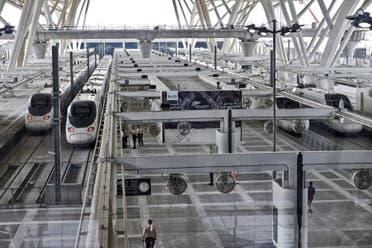
“If you have a passenger rail network through countries and it takes four hours to check passports, that that will be slightly self-defeating in terms of trying to get people out into neighboring countries,” he added.
Citing examples of the European railway being a symbol of “frictionless travel” making it a “cohesive union,” James said that a GCC rail would be “a move towards a more unified GCC” just as with the integrated, interconnected electricity grid between the countries.
“Seeing a more integrated railway link as well, it can be seen as much as a political symbol as it is a physical construction project.”
“It opens up the opportunity and potential for ways into Iraq and Turkey, into Europe, even into Jordan and potentially into Egypt and so on,” he added.
External factors delay regional progress
While Etihad Rail is steaming ahead, outside the UAE, external environmental factors and the cost of maintaining a high-speed rail network in the barren Middle East is hampering progress on the regional network.
These factors are resulting in relatively slower development compared to China and Japan which have ultra-fast bullet trains, Dr Hamad Almujibah, an engineer in the transportation sector with a specialization in railways, told Al Arabiya English.
The collaborative rail network with shared standards spanning the six Gulf Cooperation Council nations was approved in 2009 with a deadline of 2018. At the time, Saudi Arabia was the only country with a rail network.
Apart from financial and political factors, environmental issues like dune buildups from sandstorms and high temperatures for most of the year, resulted in a relatively slow progress, Almujibah, who is also an Assistant Professor at Saudi Arabia’s Taif University, said.
Shifting sand dunes can be fatal in many instances and expensive to consistently monitor and remove, Almujibah said. When sand dunes overrun train tracks, it must be removed everyday or at least every two days to avoid derailments.
Sand removal machines that operate on the same track are neither a sustainable solution nor safe owing to communication lapses, Almujibah said. The north-south rail line in Saudi Arabia, one of the longest in the world at a planned 2,750 kilometers of track, is one of many regional networks using sand removal machines, according to various reports.
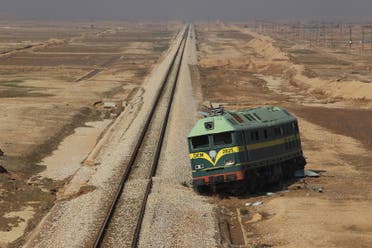
Apart from the risk of accidents between the machine and trains, there is also the cost factor from running and maintaining these machines. Additionally, camels obstructing the path of a high-speed train is a danger associated with laying tracks through the untamed desert.
The UAE has designed crossings for wildlife and has relocated animals to protected areas, after surveying the route with environmental experts and specialists. Movement patterns were monitored ahead of construction and interference from the development was mini-mized, according to previous reports.
Almujibah, who is also a Doctor of Philosophy in Engineering and the Environment, with a background in civil engineering and transportation engineering, has co-authored numerous papers on the social cost, viability and mitigation methods for Middle East rail networks.
Two methods of mitigation he recommends include building concrete barriers, ditches and dykes for short-term mitigation and adding trees to the mix in the long-run. Almujibah explored these methods in detail in his 2022 paper titled ‘Seeking Ways for Dealing with the Impacts of Sandstorms on the Railway Network in Saudi Arabia.’
The engineer said he specialized in mass transportation with specializations in rail, primarily because he forecasts a wide expansion in the MENA region, especially in Saudi Arabia. Neighboring Oman and the UAE are already full steam ahead on their internal networks, with the two signing a collaboration agreement in 2022 to construct a 303-kilometer route between Sohar and Abu Dhabi.
The UAE’s Etihad Rail network also runs to the other end of the country’s border linking Saudi Arabia.
Currently, the Kingdom runs three passenger networks – Riyadh to Dammam built in 1981; Riyadh to Qassim, Hail, Jauf; and the Haramain high-speed railway linking Mecca, Medina and Jeddah.
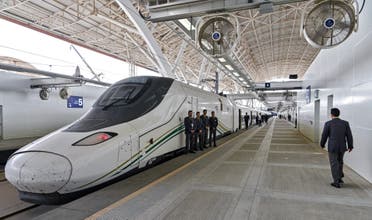
While these passenger trains are modern, with the Haramain line featuring Japan-style high-speed bullet trains, other trains that mostly carry freight have locomotives that can dispel sand on the tracks. The UAE’s Etihad Rail locomotive features a sand filtration system.
Despite the challenges, Almujibah is optimistic about the public transportation network, which he believes will only grow and connect to form a cross-border, inter-Middle East line in the years to come, making it larger than the current European network upon completion.
As a consultant on the long-awaited Riyadh metro project, Almujibah said the project with 84-stations connecting most parts of the capital city, will likely open before the end of 2023.
Integrating the metro system with the ever-growing bus lines, in addition to the airport hub and evolving rail network, the transportation specialist sees a successful integration of Saudi Arabia’s public transportation network; a move that could be replicated in the UAE.

